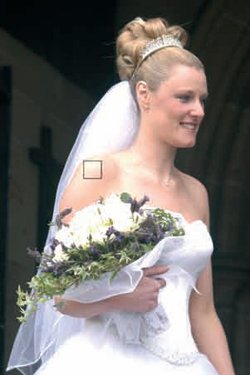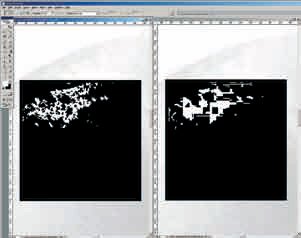articles/Digital/rawdebate-page2
The JPEG - RAW Debate - part 2 of 1 2 3 4
by Mike McNamee Published

Over exposure can be devastating! In this instance the JPEG compression has added to the woes by reducing the bit depth in the colour channels, leaving an ugly yellow scar. In the image LEFT, the yellow pixels, highlighted by the square on the bride's shoulder, have been isolated using the Threshold command on a channel. The problem is further compounded if more JPEG compression is added producing even more solid areas of blocked colour, as shown on the right.
FACT 7: JPEG files are more versatile and can be handled by a greater range of software applications than RAW files.
FACT 8: Cameras handle JPEG files faster than RAW files.
FACT 9: RAW file handling software is unique to a camera maker and the ability to process that file outside of the maker's own software is at either their whim or perhaps Adobe's, or both; it is certainly not in the control of the camera owner or the file user.

The level of compression is determined by the make-up of the image. Note how the mono, map image always remains the largest and images with solid blocks of colour are given the most compression. One problem with the shot of the bride above is that the algorithm thinks her arm is a solid block of colour.
FACT 10: You still need the same number of pixels to make a commercially saleable A4 print. It is 11MB - 'always has been!
FACT 11: RAW files are needed for legislative procedures such as court evidence. By design they cannot be tampered with (but never say never!).
FACT 12: Many people shoot both RAW and JPEG workflows, some simultaneously.
Which is good for you? If you are currently established in one route or the other and are having no issues then stick with it! If you have to handle hundreds or thousands of shots (eg a sports photographer) then you are probably best sticking with JPEG and ensuring that you get things right. If you shoot a more modest number of shots, at a more leisurely pace and you need good control of the colour and its gamut, RAW wins hands down. If you shoot JPEG, in the previous circumstances, you are at the mercy of what the camera maker thinks is the gamut you need, the contrast you need and the gamma you need - he may be right though! If you are unsure about the white balance and exposure (ie no time to test and a possible mix of illuminants) then RAW will give you more control downstream.
A conundrum for the wedding photographer is that he may fall between the two scenarios described above - quite a number of shots, and some quite tricky lighting and variations.
Please Note:
There is more than one page for this Article.
You are currently on page 2
- The JPEG - RAW Debate page 1
- The JPEG - RAW Debate page 2
- The JPEG - RAW Debate page 3
- The JPEG - RAW Debate page 4
1st Published
last update 09/12/2022 14:58:26
More Digital Articles
There are 36 days to get ready for The Society of Photographers Convention and Trade Show at The Novotel London West, Hammersmith ...
which starts on Wednesday 14th January 2026




